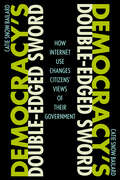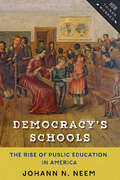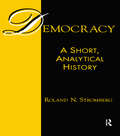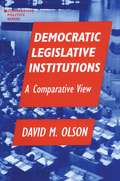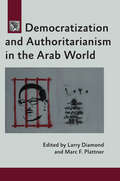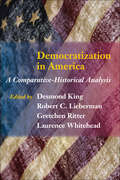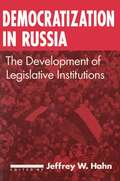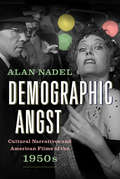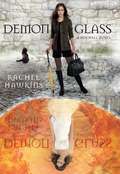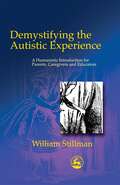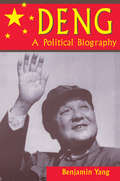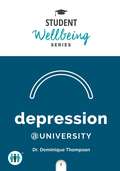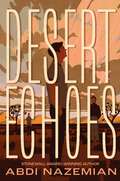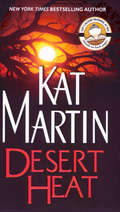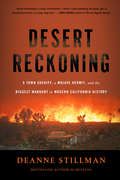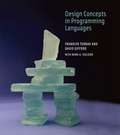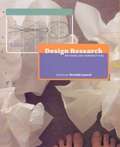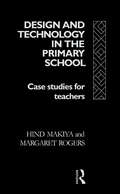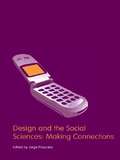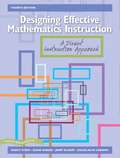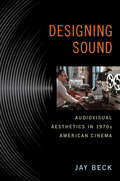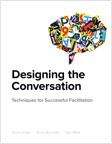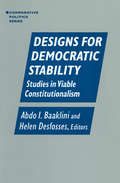- Table View
- List View
Democracy's Double-Edged Sword: How Internet Use Changes Citizens' Views of Their Government
by Catie Snow BailardThe Internet has a clear, consistent, and considerable influence on democratic satisfaction.Winner of the APSA Best Book in Information Technology and Politics of the American Political Science AssociationThe beauty of democracy is not only that citizens can vote a candidate into office but that they can also vote one out. As digital media grows omnipresent, it becomes more important for political scientists and communication scholars to understand its influence on all aspects of the political process, from campaigning to governance. Catie Snow Bailard argues that the Internet—by altering the quantity and range of information available to citizens—directly influences the ability of individuals to evaluate government performance. It also affects public satisfaction with the quality of available democratic practices and helps motivate political activity and organization.Bailard originates two theories for democratization specialists to consider—mirror-holding and window-opening—which she tests using data collected from dozens of countries and two randomized field experiments. Mirror-holding explores how accessing the Internet allows citizens to see a more detailed and nuanced view of their own government’s performance. Window-opening, however, enables those same citizens to glimpse how other governments perform, particularly in comparison to their own.Although the book offers a robust empirical foundation for testing the Internet’s effects on democratic attitudes, Bailard ultimately concludes that access to information does not necessarily ensure that democracy will automatically flourish.
Democracy's Double-Edged Sword: How Internet Use Changes Citizens' Views of Their Government
by Catie Snow Bailard“Playing into the hands of neither the cyber-optimists nor the cyber-pessimists . . . this book makes a major contribution to our understanding.” —Talia Stroud, author of Niche News: The Politics of News ChoiceThe beauty of democracy is not only that citizens can vote a candidate into office but that they can also vote one out. As digital media has grown omnipresent, it becomes more important for political scientists and communication scholars to understand its influence on all aspects of the political process, from campaigning to governance. Catie Snow Bailard argues that the Internet—by altering the quantity and range of information available to citizens—directly influences the ability of individuals to evaluate government performance. It also affects public satisfaction with the quality of available democratic practices and helps motivate political activity and organization.Bailard originates two theories for democratization specialists to consider—mirror-holding and window-opening—which she tests using data collected from dozens of countries and two randomized field experiments. Mirror-holding explores how accessing the Internet allows citizens to see a more detailed and nuanced view of their own government’s performance. Window-opening, however, enables those same citizens to glimpse how other governments perform, particularly in comparison to their own.This book offers a robust empirical foundation for testing the Internet’s effects on democratic attitudes—and reminds us that access to information does not necessarily ensure that democracy will automatically flourish.“An outstanding book on democracy and the Internet…highly original.” —Choice
Democracy's Schools: The Rise of Public Education in America (How Things Worked)
by Johann N. NeemThe unknown history of American public education.At a time when Americans are debating the future of public education, Johann N. Neem tells the inspiring story of how and why Americans built a robust public school system in the decades between the Revolution and the Civil War. It’s a story in which ordinary people in towns across the country worked together to form districts and build schoolhouses and reformers sought to expand tax support and give every child a liberal education. By the time of the Civil War, most northern states had made common schools free, and many southern states were heading in the same direction. Americans made schooling a public good.Yet back then, like today, Americans disagreed over the kind of education needed, who should pay for it, and how schools should be governed. Neem explores the history and meaning of these disagreements. As Americans debated, teachers and students went about the daily work of teaching and learning. Neem takes us into the classrooms of yore so that we may experience public schools from the perspective of the people whose daily lives were most affected by them.Ultimately, Neem concludes, public schools encouraged a diverse people to see themselves as one nation. By studying the origins of America’s public schools, Neem urges us to focus on the defining features of democratic education: promoting equality, nurturing human beings, preparing citizens, and fostering civic solidarity.
Democracy: A Short, Analytical History
by Roland N. StrombergThis text sums up the democratic experience in modern Western civilisation. It defines the term and notes the confusions in it, and its changing meanings over the past two centuries or so. It records criticisms, and is especially concerned with the conditions that are neccessary for it to exist. This encompasses a comprehensive literature which the author seeks to summarise and present to the reader in accessible form. It is appropriate material for course reading in Westen civilisation, intellectual history, political thought, and philosophy.
Democratic Legislative Institutions: A Comparative View
by David M. OlsonThis text summarizes the research on, and experiences of, democratic legislatures around the world. It focuses on what legislatures are and what they do - as both consequence of and contributor to democratic self-government.
Democratization and Authoritarianism in the Arab World (A Journal of Democracy Book)
by Larry Diamond and Marc F. PlattnerThree years after the first mass protests of the Arab Spring, senior scholars weigh in on how democracy is faring.Beginning in December 2010, a series of uprisings swept the Arab world, toppling four longtime leaders and creating an apparent political opening in a region long impervious to the "third wave" of democratization. Despite the initial euphoria, the legacies of authoritarianism—polarized societies, politicized militaries, state-centric economies, and pervasive clientelism—have proven stubborn obstacles to the fashioning of new political and social contracts. Meanwhile, the strong electoral performance of political Islamists and the ensuing backlash in Egypt have rekindled arguments about the compatibility of democracy and political Islam. Even though progress toward democracy has been halting at best, the region’s political environment today bears little resemblance to what it was before the uprisings. In Democratization and Authoritarianism in the Arab World, leading scholars address the questions posed by this period of historic change in the Middle East and North Africa. This volume includes chapters examining several broad themes: the region’s shifting political culture, the relationship between democracy and political Islam, the legacy of authoritarian ruling arrangements, the strengths and vulnerabilities of remaining autocracies, and the lessons learned from transitions to democracy in other parts of the world. It also features chapters analyzing the political development of individual countries: Algeria, Bahrain, Egypt, Jordan, Libya, Morocco, Saudi Arabia, Syria, Tunisia, Yemen, and the monarchies of the Gulf. ContributorsHicham Ben Abdallah El AlaouiApril Longley AlleyZoltan BaranyAhmed BenchemsiMieczysław P. BoduszyńskiNathan J. BrownJason BrownleeDaniel BrumbergJohn M. CareyMichele DunneAbdou Filali-AnsaryHillel FradkinF. Gregory Gause IIIHusain HaqqaniSteven HeydemannPhilip N. HowardMuzammil M. HussainAmaney JamalStéphane LacroixJuan J. LinzTarek MasoudMarc F. PlattnerTarek RadwanHamadi RedissiAndrew ReynoldsMichael RobbinsOlivier RoyPeter J. SchraederAlfred StepanMark TesslerFrédéric VolpiLucan WayFrederic WehreySean L. Yom
Democratization in America: A Comparative-Historical Analysis
by Desmond King, Robert C. Lieberman, Gretchen Ritter, and Laurence WhiteheadThe essays in this volume examine democracy’s development in the United States, demonstrating how that process has shaped—and continues to shape—the American political system.Scholars of American politics commonly describe the political development of the United States as exceptional and distinct from that of other advanced industrial democracies. They point to the United States as the longest-lived and most stable liberal democracy in history. What they often fail to mention, though, is that it took considerable time to extend democracy throughout the country.The contributors to this volume suggest that it is intellectually fruitful to consider the U.S. case in comparison to other countries. They argue that the development of democracy is ongoing in America; that even with a written constitution grounded in liberal democracy, the meaning and significance of U.S. democracy are still evolving. This volume shows that democratization and the pursuit of democracy are processes affected by multiple and continuing challenges—including such issues as citizenship, race, institution building, and political movements—as patterns and practices of politics and governance continue to change.This innovative approach contributes significantly to comparative democratization studies, a field normally confined to Latin America and former communist countries. The U.S. case is a unique reference point for students of American political development and comparative democratization.
Democratization in Russia: The Development of Legislative Institutions
by Jeffrey W. HahnThe development of Russian democracy has been a gradual process of maturation punctuated by dramatic events. This text examines events such as the first free elections, the Russian parliament's resistance to the 1991 coup, and the bloody confrontation with the military in 1993.
Demographic Angst: Cultural Narratives and American Films of the 1950s
by Alan NadelProlific literature, both popular and scholarly, depicts America in the period of the High Cold War as being obsessed with normality, implicitly figuring the postwar period as a return to the way of life that had been put on hold, first by the Great Depression and then by Pearl Harbor. Demographic Angst argues that mandated normativity—as a political agenda and a social ethic—precluded explicit expression of the anxiety produced by America’s radically reconfigured postwar population. Alan Nadel explores influential non-fiction books, magazine articles, and public documents in conjunction with films such as Singin’ in the Rain, On the Waterfront, Sunset Boulevard, and Sayonara, to examine how these films worked through fresh anxieties that emerged during the 1950s.
Demonglass (A Hex Hall Novel #2)
by Rachel HawkinsSophie Mercer thought she was a witch. That was the whole reason she was sent to Hex Hall, a reform school for delinquent Prodigium (aka witches, shapeshifters, and fairies). But that was before she discovered the family secret, and that her hot crush, Archer Cross, is an agent for The Eye, a group bent on wiping Prodigium off the face of the earth.Turns out, Sophie's a demon, one of only two in the world-the other being her father. What's worse, she has powers that threaten the lives of everyone she loves. Which is precisely why Sophie decides she must go to London for the Removal, a risky procedure that will either destroy her powers forever - or kill her. But once Sophie arrives she makes a shocking discovery. Her new housemates? They're demons too. Meaning someone is raising them in secret with creepy plans to use their powers, and probably not for good. Meanwhile, The Eye is set on hunting Sophie down, and they're using Acher to do it. But it's not like she has feelings for him anymore. Does she?
Demystifying the Autistic Experience: A Humanistic Introduction for Parents, Caregivers and Educators
by William StillmanParents, caregivers and educators are often at a loss about how best to support an individual with autism because they are overwhelmed by 'behaviours', inundated with prognoses and clinical jargon, or confused by technical information. This book introduces autism from a non-clinical, humanist perspective, emphasizing that we are all more alike than different. The author deconstructs the fundamental concepts of the autistic experience using language, examples and anecdotes that are concrete and understandable for all. Reinforced for the reader is the importance of listening carefully to what people are telling us about valuing differences, personal passions, communication, and holistic wellness.
Deng: A Political Biography
by Benjamin YangA comprehensive exposition of the life of Deng Xiaoping, the pre-eminent leader of late 20th-century China, from his birth in 1904 to the present. Written by an insider, this study is notable for the detail it provides on elite-level Chinese Communist Party politics and Deng's changing relations with his party colleagues in the jockying for power that constitutes a significant aspect of CCP politics. This biography combines intimate details, and the sweep of history that encompasses the struggles of 20th-century China. This text provides both political and personal information that may be of interest to students of Chinese history, as well as providing an insight into the man who has influenced the social, political, and economic development of China.
Depression at University (Student Wellbeing Series)
by Dominique ThompsonThis illustrated pocket book offers advice, practical tips, and useful exercises for students to combat low moods and depression at university. Written by the award-winning student mental health specialist, Dr Dominique Thompson, this easy-to-read guide will ensure that students have all the tools they need to understand the sources of their depression and take steps to reclaim their life from its debilitating effects.Although plenty of people talk about depression, there are still a lot of misconceptions about it. This book will clearly explore what depression is, and investigate the ways in which it can affect anyone. With extracts from students’ own accounts about their depression, and how they learned to manage it, and lots of practical, easy-to-follow examples and exercises, the book will help readers understand their depression, so they can deal with it in the right way for them.Above all, this book will help readers gain real power over their depression so that they can enjoy the full university experience on their terms.
Desert Echoes
by Abdi NazemianFrom Abdi Nazemian, the award-winning author of Like a Love Story and Only This Beautiful Moment, comes a suspenseful contemporary YA novel about loss and love.Fifteen-year-old Kam is head over heels for Ash, the boy who swept him off his feet. But his family and best friend, Bodie, are worried. Something seems off about Ash. He also has a habit of disappearing, at times for days. When Ash asks Kam to join him on a trip to Joshua Tree, the two of them walk off into the sunset . . . but only Kam returns.Two years later, Kam is still left with a hole in his heart and too many unanswered questions. So it feels like fate when a school trip takes him back to Joshua Tree. On the trip, Kam wants to find closure about what happened to Ash but instead finds himself in danger of facing a similar fate. In the desert, Kam must reckon with the truth of his past relationship—and the possibility of opening himself up to love once again.Desert Echoes is a propulsive, moving story about human resilience and connection.
Desert Heat (Sinclair Sisters Trilogy #2)
by Kat Martin"Kat Martin writes irresistible novels." --RT Book ReviewsIt takes a certain kind of rough and tumble man to show a Sinclair girl how to ask for everything she wants. . . For Patience Sinclair, leaving the ivy-covered halls of Boston for the wide, open spaces of Texas means a chance to stop looking over her shoulder at every turn. Traveling incognito with the Triple C Rodeo is just what she needs to free her from a past that continues to haunt her. But she can't avoid the undeniable presence of Dallas Kingman. The champion rider has a way of letting her know he's watching her every move that makes her feel wild and reckless. As they make their way through the heart of the southwest, a series of mysterious accidents darkens the promise of the unknown into a vortex of fear and obsession, and Patience finds herself closer to danger than she could have ever imagined. . ."Enthralling. . .guaranteed to give you hours of reading pleasure." --RT Book Reviews on The Silent Rose
Desert Reckoning: A Town Sheriff, a Mojave Hermit, and the Biggest Manhunt in Modern California History
by Deanne StillmanAward-winning nonfiction author Stillman offers a novelistic depiction of the Mojave Desert manhunt for Donald Kueck, a desert hermit who shot and killed deputy sheriff Stephen Sorensen when Sorensen approached Kueck's trailer on a routine check. She begins with background on the violent history of the desert region, then depicts present-day Antelope Valley, an hour's drive north of Los Angeles, as a place where loners and outcasts build make-shift homesteads. Stillman's narrative gets into the minds of both men as they navigate the territory of one of the last American frontiers. The book is based on Stillman's Rolling Stone article, "The Great Mojave Manhunt. " Each chapter opens with a b&w image of the region. Stillman teaches in the MFA Creative Writing Program at the University of California-Riverside-Palm Desert. Annotation ©2012 Book News, Inc. , Portland, OR (booknews. com)
Design Concepts in Programming Languages
by Franklyn Turbak David Gifford Mark A. SheldonChoice Outstanding Academic Title, 2009. Hundreds of programming languages are in use today--scripting languages for Internet commerce, user interface programming tools, spreadsheet macros, page format specification languages, and many others. Designing a programming language is a metaprogramming activity that bears certain similarities to programming in a regular language, with clarity and simplicity even more important than in ordinary programming. This comprehensive text uses a simple and concise framework to teach key ideas in programming language design and implementation. The book's unique approach is based on a family of syntactically simple pedagogical languages that allow students to explore programming language concepts systematically. It takes as its premise and starting point the idea that when language behaviors become incredibly complex, the description of the behaviors must be incredibly simple. The book presents a set of tools (a mathematical metalanguage, abstract syntax, operational and denotational semantics) and uses it to explore a comprehensive set of programming language design dimensions, including dynamic semantics (naming, state, control, data), static semantics (types, type reconstruction, polymporphism, effects), and pragmatics (compilation, garbage collection). The many examples and exercises offer students opportunities to apply the foundational ideas explained in the text. Specialized topics and code that implements many of the algorithms and compilation methods in the book can be found on the book's Web site, along with such additional material as a section on concurrency and proofs of the theorems in the text. The book is suitable as a text for an introductory graduate or advanced undergraduate programming languages course; it can also serve as a reference for researchers and practitioners.
Design Research: Methods and Perspectives
by Brenda Laurel Peter LunenfeldThe tools of design research, writes Brenda Laurel, will allow designers "to claim and direct the power of their profession." Often neglected in the various curricula of design schools, the new models of design research described in this book help designers to investigate people, form, and process in ways that can make their work more potent and more delightful. "At the very least," Peter Lunenfeld writes in the preface, "design research saves us from reinventing the wheel. At its best, a lively research methodology can reinvigorate the passion that so often fades after designers join the profession." The goal of the book is to introduce designers to the many research tools that can be used to inform design as well as to ideas about how and when to deploy them effectively. The chapter authors come from diverse institutions and enterprises, including Stanford University, MIT, Intel, Maxis, Studio Anybody, Sweden?s HUMlab, and Big Blue Dot. Each has something to say about how designers make themselves better at what they do through research, and illustrates it with real world examples--case studies, anecdotes, and images. Topics of this multi-voice conversation include qualitative and quantitative methods, performance ethnography and design improvisation, trend research, cultural diversity, formal and structural research practice, tactical discussions of design research process, and case studies drawn from areas as unique as computer games, museum information systems, and movies. Interspersed throughout the book are one-page "demos," snapshots of the design research experience. Design Research charts the paths from research methods to research findings to design principles to design results and demonstrates the transformation of theory into a richly satisfying and more reliably successful practice.
Design and Technology in the Primary School: Case Studies for Teachers (Subjects in the Primary School)
by Margaret Rogers Hind MakiyaThe inclusion of technology among the National Curriculum foundation subjects is an exciting , but at the same time somewhat daunting challenge for primary teachers. This series of case studies shows how real teachers across the primmary age range have put design and technology into practice as a focus for their topic work. Through these examples Margaret Rogers and Hind Makiya show what is meant by design and technology in the primary school and how problem solving activiies can be used to fulfil the requirements of the National Curriculum across several subjects. Useful appendices summarize the technology requirements of the National Curriculum and give extra guidance in common areas of difficulty such as the introduction of electricity and the use of electricity and the use of technical lego.
Design and the Social Sciences: Making Connections
by Jorge FrascaraThe social sciences have a distinctive contribution to make to the understanding and handling of design issues, both in product and systems design and in the design of the built environment. The role of cognitive psychology, particularly ergonomics, to the design process has traditionally been well appreciated. Because it provides important insight
Design of Experiments: Statistical Principles of Research Design and Analysis (2nd Edition)
by Robert O. KuehlThis edition prepares students to design and analyze experiments that will help them succeed in the real world. The author uses a large array of real data sets from a broad spectrum of scientific and technological fields. He emphasizes the importance of developing a treatment design based on a research hypothesis as an initial step, then developing an experimental or observational study design that facilitates efficient data collection.
Designing Effective Mathematics Instruction: A Direct Instruction Approach
by Jerry Silbert Marcy Stein Douglas W. Carnine Diane B. KinderFor courses in Mathematics in Special Education. Providing teachers with the information needed to design supplemental mathematics instruction and to evaluate and modify commercially developed math programs, Designing Effective Mathematics Instruction, Fourth Edition, gives teachers systematic procedures and teaching strategies to augment instruction. The new edition discusses the history and components of the direct instruction approach to teaching mathematics, as well as relevant and current research skills and techniques required for effective mathematics instruction, including strategies for pacing lessons, correcting errors, and diagnosing and remedying error patterns. Designing Effective Mathematics Instruction also contains Instructional Sequence and Assessment Charts for primary, intermediate, and remedial teachers, which serve as diagnostic tests or as a basis for constructing goals and objectives for students.
Designing Sound: Audiovisual Aesthetics in 1970s American Cinema
by Jay BeckThe late 1960s and 1970s are widely recognized as a golden age for American film, as directors like Francis Ford Coppola, George Lucas, and Martin Scorsese expanded the Hollywood model with aesthetically innovative works. As this groundbreaking new study reveals, those filmmakers were blessed with more than just visionary eyes; Designing Sound focuses on how those filmmakers also had keen ears that enabled them to perceive new possibilities for cinematic sound design. Offering detailed case studies of key films and filmmakers, Jay Beck explores how sound design was central to the era's experimentation with new modes of cinematic storytelling. He demonstrates how sound was key to many directors' signature aesthetics, from the overlapping dialogue that contributes to Robert Altman's naturalism to the wordless interludes at the heart of Terrence Malick's lyricism. Yet the book also examines sound design as a collaborative process, one where certain key directors ceded authority to sound technicians who offered significant creative input. Designing Sound provides readers with a fresh take on a much-studied era in American film, giving a new appreciation of how artistry emerged from a period of rapid industrial and technological change. Filled with rich behind-the-scenes details, the book vividly conveys how sound practices developed by 1970s filmmakers changed the course of American cinema.
Designing the Conversation: Techniques for Successful Facilitation
by Dan Willis Russ Unger Brad NunnallyFacilitation skills are the foundation of every successful design practice, yet training on this core competency has been largely unavailable--until now. Designing the Conversation: Techniques for Successful Facilitation is a complete guide to developing the facilitation skills you need to communicate effectively and design fully engaging experiences. Learn to take control as Russ Unger, Brad Nunnally, and Dan Willis show you how to use your skills as a facilitator to deftly extract information from different types of people in various scenarios and address any problems and needs that arise along the way. With this book, you will learn how to: Bring together different cross-functional project teams, stakeholders, and clients while balancing their needs, goals, and requirements with those of users Prepare for activities through agenda setting, planning for different types of personalities, and identifying the method of practicing that works best for you Perform group facilitation in workshops, brainstorming sessions, and focus groups Manage individual facilitation activities through interviews, usability testing, sales calls, and mentoring Conduct one-to-many facilitation activities such as presentations, virtual seminars, and lectures Understand how to manage Q & A from audiences of all sizes
Designs for Democratic Stability: Studies in Viable Constitutionalism
by Abdo I. Baaklini Helen DesfossesSince the 1980s and the collapse of communist, military, and race-based regimes across the world, the euphoria has given way to the question of how to enhance the viability of democratic constitutional government. This text covers this issue.
